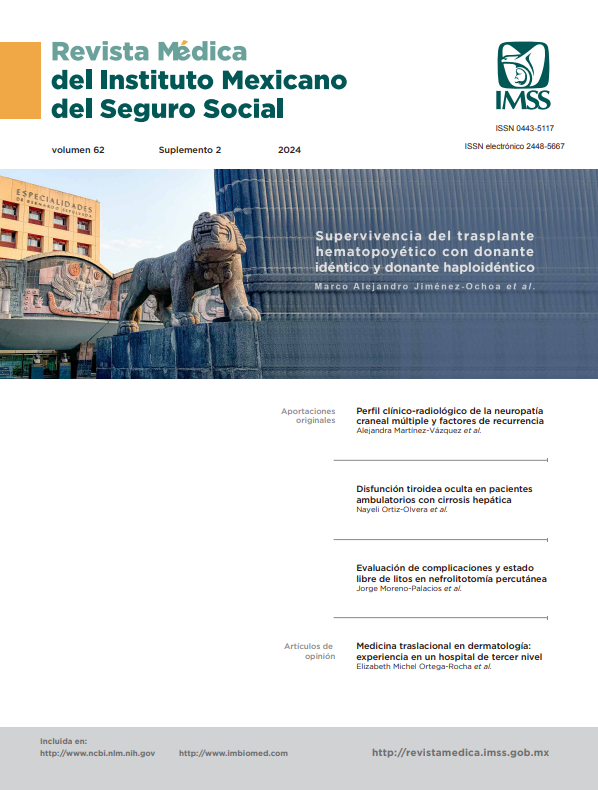Assessment of complications and stone free status in percutaneous nephrolithotomy
Main Article Content
Keywords
Cohort Studies, Risk Factors, Percutaneous, Nephrolithotomy, Nephrolithiasis
Abstract
Background: Percutaneous nephrolithotomy (PNL) is the first line treatment for kidney stones with a diameter > 2 cm. The available scores for measuring success in this procedure only consider the free stone status, without considering the complications.
Objective: To present a new prognostic stratification system to predict treatment failure in PNL.
Material and methods: Historic cohort in which prognostic factors and failure as residual stone with or without complication were identified. A bivariate analysis was performed using the numeric variables and with the use of conjunctive consolidation a prognostic stratification system was developed.
Results: A total of 595 cases were included, out of which 73% concluded with free stone status and 12% developed major complications. 66% fulfilled the proposed success definition. In the first conjunct consolidation, a positive urine culture and a complex stone were identified as risk factors; after making one more conjunction with another stratum, the severe Charlson Comorbidity Index (CCI) was also identified as a risk factor. Finally, an operating time ≥ 120 minutes was added as an intraoperative factor that increases risk.
Conclusions: The variables positive urine culture, severe CCI, complex stone and prolonged operating time are associated with major complications and residual stone. The proposed score is a simple and predictive tool that can be used in daily practice, given that it includes 3 pre-operative variables. The treatment success or failure rate of the score can be applied in the selection of patients ongoing PNL.
References
Sabler IM, Katafigiotis I, Gofrit ON, et al. Present indications and techniques of percutaneous nephrolithotomy: What the future holds? Asian J Urol. 2018;5(4):287-94. doi: 10.1016/j.ajur.2018.08.004.
Jiang P, Xie L, Arada R, et al. Qualitative Review of Clinical Guidelines for Medical and Surgical Management of Urolithiasis: Consensus and Controversy 2020. J Urol. 2021;205(4):999-1008. doi: 10.1097/JU.0000000000001478.
Singh AK, Shukla PK, Khan SW, et al. Using the Modified Clavien Grading System to Classify Complications of Percutaneous Nephrolithotomy. Curr Urol. 2018;11(2):79-84. doi: 10.1159/000447198.
Biswas K, Gupta SK, Tak GR, et al. Comparison of STONE score, Guy’s stone score and Clinical Research Office of the Endourological Society (CROES) score as predictive tools for percutaneous nephrolithotomy outcome: a prospective study. BJU Int. 2020;126(4):494-501. doi: 10.1111/bju.15130.
El-Nahas AR, Nabeeh MA, Laymon M, et al. Preoperative risk factors for complications of percutaneous nephrolithotomy. Urolithiasis. 2021;49(2):153-60. doi: 10.1007/s00240-020-01203-9.
Zhou G, Zhou Y, Chen R, et al. The influencing factors of infectious complications after percutaneous nephrolithotomy: a systematic review and meta-analysis. Urolithiasis. 2022;51(1):17. doi: 10.1007/s00240-022-01376-5.
Moreno-Palacios J, Avilés-Ibarra OJ, López-Samano VA, et al. Tasa libre de litos sin complicación mayor como definición de éxito en nefrolitotomía percutánea. Gac Med Mex. 2019;155(1):52-7. doi: 10.24875/GMM.18004474.
Falahatkar R, Falahatkar S, Khajavi Gaskarei MA, et al. The global, prevalence, and risk factors of postoperative fever after percutaneous nephrolithotomy: A systematic review and meta-analysis. Asian J Urol. 2023. doi: 10.1016/j.ajur.2022.04.008.
Mazzon G, Choong S, Celia A. Stone-scoring systems for predicting complications in percutaneous nephrolithotomy: A systematic review of the literature. Asian J Urol. 2023;10(3):226-38. doi: 10.1016/j.ajur.2023.01.005.
Talavera JO, Roy-García I, Díaz-Torres ST, et al. Expresión numérica del curso clínico de la enfermedad. Manejo de datos. Rev Med Inst Mex Seguro Soc. 2023;61 Supl 3:S503-9. doi: 10.5281/zenodo.8319834.
Sierra-Díaz E, Dávila-Radilla F, Espejo-Vázquez A, et al. Incidencia de fiebre y hemorragia post nefrolitotomía percutánea: un estudio de cohorte prospectivo. Cir Cir. 2022;90(1). doi: 10.24875/CIRU.20001130.
Skolarikos A, Jung H, Neisius A, et al. Urolithiasis. In: European Association of Urology Guidelines on Urolithiasis. Last update 2023. Disponible en: https://uroweb.org/guidelines/urolithiasis.
Feinstein AR. Clinical biostatistics. XIV. The purposes of prognostic stratification. Clin Pharmacol Ther. 1972;13(2):285-97. doi: 10.1002/cpt1972132285.
Feinstein AR. Clinical biostatistics. XVI. The process of prognostic stratification. 2. Clin Pharmacol Ther. 1972;13(4):609-24. doi: 10.1002/cpt1972134609.
Feinstein AR. Clinical biostatistics. XV. The process of prognostic stratification. I. Clin Pharmacol Ther. 1972;13(3):442-57. doi: 10.1002/cpt1972133442.
Geraghty RM, Davis NF, Tzelves L, et al. Best Practice in Interventional Management of Urolithiasis: An Update from the European Association of Urology Guidelines Panel for Urolithiasis 2022. Eur Urol Focus. 2023;9(1):199-208. doi: 10.1016/j.euf.2022.06.014.
Large T, Assmus MA, Valadon C, et al. A Multi-institutional Review of Single- access Percutaneous Nephrolithotomy for Complex Staghorn Stones. Eur Urol Focus. 2021;7(5):1170-5. doi: 10.1016/j.euf.2020.11.005.
Zeng G, Zhong W, Mazzon G, et al. International Alliance of Urolithiasis (IAU) Guideline on percutaneous nephrolithotomy. Minerva Urol Nephrol. 2022;74(6):653-68. doi: 10.23736/S2724-6051.22.04752-8.
Lai S, Jiao B, Jiang Z, et al. Comparing different kidney stone scoring systems for predicting percutaneous nephrolithotomy outcomes: A multicenter retrospective cohort study. Int J Surg. 2020;81:55-60. doi: 10.1016/j.ijsu.2020.07.025.
Al Adl AM, Mohey A, Abdel Aal A, et al. Percutaneous Nephrolithotomy Outcomes Based on S.T.O.N.E., GUY, CROES, and S-ReSC Scoring Systems: The First Prospective Study. J Endourol. 2020;34(12):1223-8. doi: 10.1089/end.2019.0856.
Skolarikos A, Somani B, Davis ND, et al. Urolithiasis Guidelines. EAU Guidelines: Arnhem; 2023.
Chen X, Peng PX, He YH, et al. [Evaluation and Comparison of SHA.LIN,S.T.O.N.E.Nephrolithometry Scoring System,and Clinical Research Office of the Endourological Society Nephrolithometry Nomogram for Predicting Stone Free Rate and Postoperative Outcomes after Percutaneous Nephrolithotomy]. [Article in Chinese]. Zhongguo Yi Xue Ke Xue Yuan Xue Bao. 2019;41(4):492-500. doi: 10.3881/j.issn.1000-503X.10767.
Akçay M, Tosun M, Gevher F, et al. Comparison of Scoring Systems in Predicting Success of Percutaneous Nephrolithotomy. Balkan Med J. 2019;36(1):32-36. doi: 10.4274/balkanmedj.2017.1631.
Opondo D, Tefekli A, Esen T, et al. Impact of case volumes on the outcomes of percutaneous nephrolithotomy. Eur Urol. 2012;62(6):1181-7. doi: 10.1016/j.eururo.2012.03.010.
Zhu H, Liu B, Karagöz MA, et al. Reasons and risk factors for delayed discharge after day-surgery percutaneous nephrolithotomy. BMC Urol. 2022;22(1):209. doi: 10.1186/s12894-022-01159-5.
Kumar U, Tomar V, Yadav SS, et al. STONE score versus Guy’s Stone Score - prospective comparative evaluation for success rate and complications in percutaneous nephrolithotomy. Urol Ann. 2018;10(1):76-81. doi: 10.4103/UA.UA_119_17.


